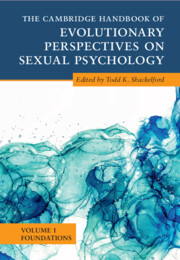Book contents
- The Cambridge Handbook of Evolutionary Perspectives on Sexual Psychology
- The Cambridge Handbook of Evolutionary Perspectives on Sexual Psychology
- Copyright page
- Contents
- Contributors
- Preface
- Part I Foundations of Evolution
- Part II Middle-Level Theories
- 7 Parental Investment Theory
- 8 Parent–Offspring Conflict
- 9 Theory and Evidence for Reciprocal Altruism
- 10 Life History Theory and Mating Strategies
- 11 Sperm Competition Theory
- 12 Sexual Conflict Theory
- 13 Cross-Species Comparisons
- 14 Cross-Cultural Methods in Sexual Psychology
- 15 Behavioral Genetics
- 16 Sex Differences and Sex Similarities
- 17 Individual Differences in Sexual Psychology
- 18 Experimental Methods in Sexual Psychology
- Index
- References
7 - Parental Investment Theory
from Part II - Middle-Level Theories
Published online by Cambridge University Press: 30 June 2022
- The Cambridge Handbook of Evolutionary Perspectives on Sexual Psychology
- The Cambridge Handbook of Evolutionary Perspectives on Sexual Psychology
- Copyright page
- Contents
- Contributors
- Preface
- Part I Foundations of Evolution
- Part II Middle-Level Theories
- 7 Parental Investment Theory
- 8 Parent–Offspring Conflict
- 9 Theory and Evidence for Reciprocal Altruism
- 10 Life History Theory and Mating Strategies
- 11 Sperm Competition Theory
- 12 Sexual Conflict Theory
- 13 Cross-Species Comparisons
- 14 Cross-Cultural Methods in Sexual Psychology
- 15 Behavioral Genetics
- 16 Sex Differences and Sex Similarities
- 17 Individual Differences in Sexual Psychology
- 18 Experimental Methods in Sexual Psychology
- Index
- References
Summary
Parental Investment Theory, as an overarching theory in evolutionary biology, has not only deepened our understanding of sexual selection and mate preferences, as is evident in this chapter, but has also contributed to our understanding of the underlying mechanisms producing sexual behavior in all sexually reproducing species, including humans. In evolutionary biology, parental investment, as formulated by Robert Trivers in 1972, is any cost or expenditure (e.g., resources, time, energy) associated with raising offspring that increases that offspring’s chances of survival or reproductive success, and reduces a parent’s ability to invest in other or future offspring. There are many applications of Parental Investment Theory when considering the behavior of sexually reproducing species; however, the current chapter focuses on the implications of the evolution of asymmetrical parental investment for human sexual psychology. Parental investment theory has inspired new theories in the human evolutionary sciences addressing sexual preference and mating behaviors, including sex difference in sexual preferences and attraction tactics, emergence of intrasexual competition and intersexual selection, cognitive biases in perceptions of sexual intent, sexual coercion and rape, female coyness and sexual regret, mate guarding and sex difference in sexual jealousy, and sex differences in the consumption of sexually explicit content and the psychology of extramarital relationships. This chapter considers how knowledge of asymmetric parental investment, which is a result of the evolution of sexual reproduction, has contributed to our understanding of sexual behavior and psychology. Finally, ecological variation in parental investment across different human populations due to environmental harshness and demand, as well as the importance of cross-cultural research in human sexual psychology, are discussed.
- Type
- Chapter
- Information
- Publisher: Cambridge University PressPrint publication year: 2022

